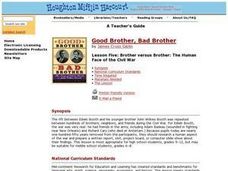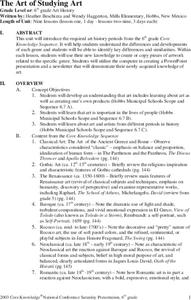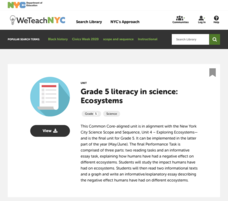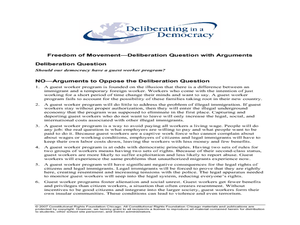Curated OER
Art and Culture
Learners compare and contrast the ways in which human figures are portrayed in rock art made by ancient Native American artists and in the drawings and paintings of historic European and American artists. They use images to identify...
EngageNY
Grade 9 ELA Module 2, Unit 3, Lesson 5
After rereading the full text of Walter Mosley's essay "True Crime," groups complete an evidence collection tool worksheet, and then class members independently draft a multi-paragraph, evidence-based response that identifies how Mosley...
Curated OER
Brother versus Brother: The Human Face of the Civil War
Students research a human aspect of the Civil War and prepare a written report, skit, project board, or computer slide-show about their findings. They focus on how the war affected families who had members on opposing sides of the conflict.
Curated OER
Humans and the Natural World Poetically
Students read poetry for gist and find images to create a visual narrative. For this poetry lesson, students read Green Lane and Flies and Nettles to examine the relationship between humanity and the nature. Students reflect...
Curated OER
For the Well-being of Our Citizens Lesson 2: Poverty And Human Rights
Students investigate the definitions of poverty and impoverishment. They design a poster that show the Articles of the Universal Declaration of Human Rights that are violated by poverty. They write an article for the school newspaper...
Curated OER
The Art of Studying Art
Students explain the value of different genres of art. In this art lesson, students describe the differences in various genres of art and make comparisons between them. Students choose an art genre and create an original work of art...
Curated OER
Overcoming Censorship Through Art
Students examine and discuss government-imposed censorship of art and artists' methods for counteracting censorship. They view censored artwork, write a persuasive essay, and create an art piece.
Curated OER
The Holocaust in Art, Photography and Writing
Students explore paintings, photographs and writings about the Holocaust using the internet. Researching the various websites, they will discover different human experiences of Holocaust victims. After researching, students write about...
Curated OER
Sexual Exploitation: Consent vs. Exploitation
Students read about human behavior by completing a worksheet in class. In this sexual activity instructional activity, students identify the importance about consenting to sexual behavior as opposed to being forced into it or being...
Curated OER
Dr. Martin Luther King, Jr., a study in celebrating people
Students analyze obstacles in their own life by studying Dr. Martin Luther King, Jr. In this humanity lesson, students create T-charts listing the obstacles one faces in life and how they can be overcome. Students compare and contrast...
Curated OER
The Invisible People: American Art and Literature Represents the Marginalized and Disenfranchised
Students view various pieces of art and sculptures which demonstrates people who are marginalized and invisible. While viewing the art, they are read excerpts of different pieces of literature in which they determine why the author or...
Curated OER
Art and Propaganda
Students examine the types of propaganda used throughout World War II. In groups, they view examples of different posters and artwork used to identify the human emotions the government was trying to appeal through. They develop their...
Curated OER
Understanding Human Rights Through Music And Poetry
Tenth graders discuss human rights. They brainstorm and listen to and read examples of music and poetry that deal with human rights and oppression. They choose one poem or song to analyze, looking for theme, oppression, and historical...
Curated OER
Variation in Human Skin Color
Students explore factors that control variation in human skin color and the implications of this information for human society. They understand that skin color is no longer considered a credible scientific standard by which to classify...
Equality and Human Rights Commission
Taking Action
The Universal Declaration of Human Rights passed in 1948 when the majority of members of the United Nations voted in favor of the resolution. Scholars use their knowledge of human rights to determine ways they personally can help promote...
University of Texas
Understanding Migration
Human migration—often the result of push and pull factors—sometimes has dramatic outcomes for both those leaving their homelands and the host countries. Using a variety of case studies, learners consider those issues. Then, by completing...
New York City Department of Education
Grade 5 Literacy in Science: Ecosytems
How do humans affect ecosystems? Learners read two articles and interpret a graph to develop essays on the human impact on ecosystems. They read about human impact on tigers and manatees as a basis for their overarching papers.
EduGAINs
Go Eco! Ecosystems
How is a movie theater like a desert biome? Compare systems to ecosystems with a set of activities that focuses on accessing multiple intelligences and building upon knowledge. As learners discuss the ways elements of an ecosystem depend...
San Francisco Symphony
Music and Early Man
Creative projects are great ways to increase interest in topical research. Middle schoolers learning about primitive life styles in the Americas explore the importance of music to hunter gatherers. They research and create musical...
Deliberating in a Democracy
Freedom of Movement
Class members examine human migration. For this population lesson, they read an article entitled, "Freedom of Movement" and respond to discussion questions about the article related to guest worker programs.
Curated OER
The Northern Renaissance
Differentiating between Northen European art and Italian art, these slides detail the intricacies of art during the Renaissance. The presentation features Flemish, French, German, and English art, as well as the art of Austria, Spain,...
University of Minnesota
Beautiful Brain: Step Inside the Brain
Before digital microscopes, scientists hired artists to draw the things visible in the microscope. Through training in neuroscience and art, Cajal revolutionized the way we view the beautiful brain. The third lesson in a series of four...
EngageNY
Summarizing Complex Ideas: Comparing the Original UDHR and the "Plain Language" Version
The eighth lesson plan in this series continues the focus on vocabulary and increasing young readers' awareness of academic language. Pairs of learners participate in a short vocabulary review activity called Interactive Words in which...
EngageNY
Comparing Text to Multimedia: Understanding How the Brain Changes
Learners explore how the human brain changes over time, comparing an interactive web page about brain development to a text-only version. Additionally, pupils continue reading an article about teen decision making, analyzing the main...























